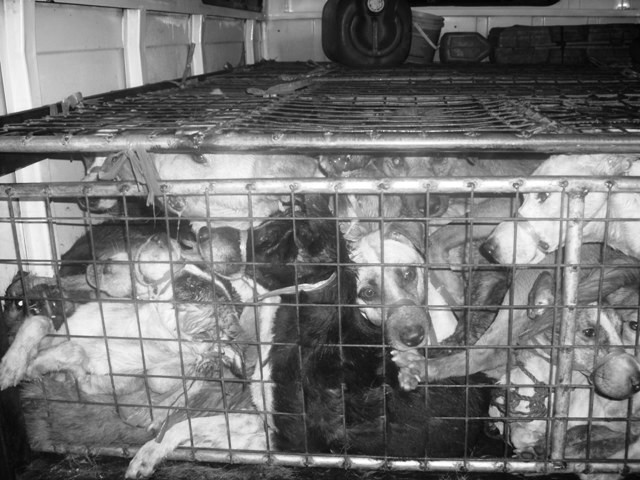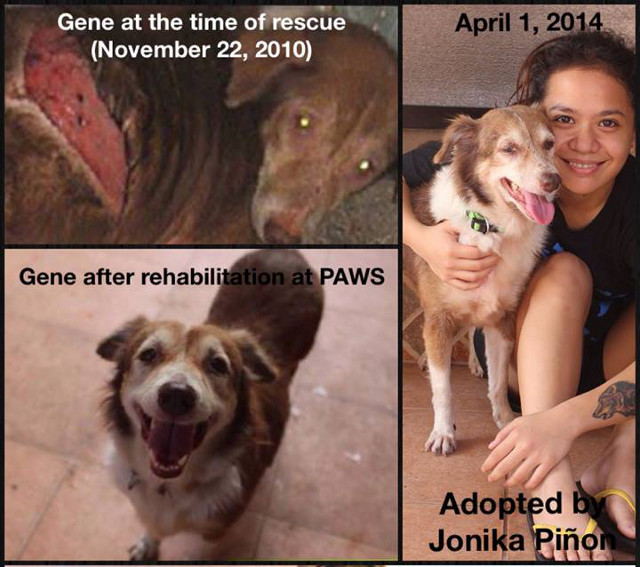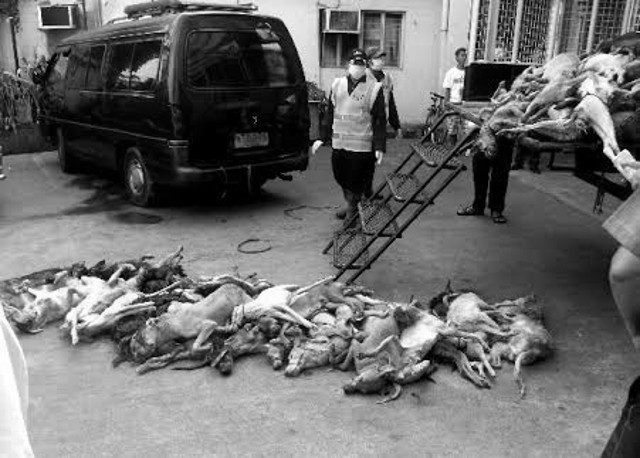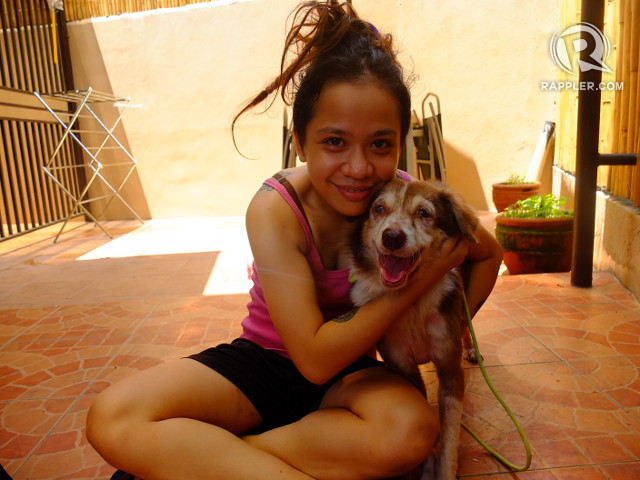SUMMARY
This is AI generated summarization, which may have errors. For context, always refer to the full article.

(WARNING: Some photos in the article may be disturbing to some readers.)
MANILA, Philippines – When animal rescuers found Gene, an Aspin (asong pinoy), hiding in someone’s house in Fairview, Quezon City, she had a 5-inch-wide gash of bleeding raw skin on her side.
One of the neighbors apparently wanted to have her for dinner.
“She was really scared. She was one of the most untrusting dogs I’ve ever encountered,” said Philippine Animal Welfare Society (PAWS) volunteer Jonika Piñon when she first laid eyes on Gene in their Quezon City rehabilitation center 4 years ago.
Tail between her legs, ears folded back and with her entire body leaning as far away from humans as she could, Gene’s fear bled out of her like blood – metallic, acrid, repellent.
It took years before Gene, now a gentle 12-year-old with startlingly light eyes and faded brown and white fur, to start trusting humans again. Adopted by Piñon, she can expect to live the rest of her days loved and cared for.
The same cannot be said of hundreds of dogs who are butchered everyday in the Philippines to supply the unrelenting and unregulated demand for dog meat.
Despite a law banning the killing and maltreatment of dogs (Animal Welfare Act of 1998), dog-eating and the industry that supplies it continues particularly in the northern part of the country. Only last June 23, some 12 dogs were rescued in San Pedro Laguna, according to the Department of Agriculture (DA).

The fight against Philippine dog meat trade is getting a boost from a July 3 forum held in Baguio City, where dog-eating is still prevalent.
Fighting the trade
During the forum, the Philippine government crafted a national action plan against dog meat trade, the first such nation-wide plan in Asia, according to Animal Kingdom Foundation (AKF) President Charles Wartenberg.
“If the country will be successful in this campaign, the country will be gaining more respect and recognition internationally as the first to come up with serious measures against the illegal trade,” he said.
The action plan, still in draft form, will be spearheaded by the DA’s Bureau of Animal Industry (BAI), National Meat Inspection Service (NMIS), Department of the Interior and Local Government (DILG), and AKF as the civil society watchdog.
The campaign also requires the involvement of local government officials, the police, city and provincial veterinarians and the National Commission for Indigenous Peoples (NCIP).
The action plan aims to eliminate the country’s dog meat trade by 2016, AKF Head and Legal Counsel Heidi Caguioa told Rappler.
Eradication means no more dog meat traders and no more dog meat restaurants.
The action plan includes a massive information education campaign and the creation of a taskforce to monitor the illegal trade and catch those involved in it.
There will also be a spay and neuter campaign to control the population of stray dogs that provide endless supply for the trade.
After the draft of the action plan is completed, the agencies involved will ask for an Executive Order from President Benigno Aquino III to operationalize the campaign.
‘Cruel, inhumane’
Most buying and selling of dog meat occurs in the northern Philippines, particularly in Benguet, Ifugao and Kalinga provinces.
A Kalinga local told Rappler that eating dogs has been the practice in these communities since the time of their ancestors. When eaten, dog meat makes the human body “feel hot,” a welcome sensation in the cold climes of these mountainous provinces.

There are “underground” dog meat restaurants still operating in Session Road and Marcos Highway, Baguio City and in La Trinidad, Benguet, according to Caguioa.
Most of the dogs eaten here come from Calabarzon (Region IV-A).
“The dog meat traders send people who buy dogs from the community, those who don’t want their dogs anymore, or worse, dognaps. We get tips from subdivisions who tell us every morning someone goes around in their village in a pedicab buying dogs,” she said.
The dogs are bought for P100 to P120 (US$2.3-2.8). They are tied by the mouth and feet and thrown in trucks or vans. Raids Caguioa has participated in showed that as much as 70 to 100 dogs may be crammed in the back of a single truck.
“They are like sardines. They can’t breathe, they can’t move. By the time they reach Baguio or Pangasinan, 70% of them are already dead,” she described.
In some cases, the dogs’ mouths are closed shut by wires. Makisig, a dog rehabilitated by PAWS, had his mouth closed so tightly by wire that fur never grew back where the wire had been, said Piñon.
When they get to the “slaughterhouse,” the dogs are beaten to death on the head with a bambo, a metal rod or heavy wood. Most of the time, the dogs don’t die with just one blow. As they suffer, the rest of the dogs watch, which animal advocates say, causes fear and stress.
‘Infected’ dog meat
Though the cruelty of the trade would make any pet owner weep, the national action plan against it is crafted with health issues at the forefront.
This is the new strategy being employed against dog meat trade elsewhere in Asia.
“We do not believe that attacking the dog meat industry on the grounds of cruelty will be effective…Targeting health issues is the way to,” said John Dalley, Vice President of Thailand-based Soi Dog Foundation, in May 2013.
Eating dog meat can pose serious health risks especially given the way the dogs are handled and the meat prepared.
The dogs are taken from the streets and have usually already contracted skin diseases like mange (galis) and tumors, bacteria and worms.
Humans can also get cholera and the gastrointestinal disease trichinellosis from eating or preparing dog meat, according to the World Health Organisation (WHO).
Since the dog meat trade necessitates the transportation of dogs across great distances, it can also widen the spread of rabies and put more dogs and humans at risk.
A scene in a dimly lit slaughterhouse in La Trinidad, Benguet was enough to convince Caguioa that dog meat is not safe to eat.
“When they brought a light in, it was full of blood, innards were scattered around or were hanging. It was very smelly. The meat was just on the ground or in very dirty bowls. Are you going to eat something like that?”
But worse than knowingly eating dog meat is unknowingly eating it. According to the DA, dog meat is often mixed with goat meat by “enterprising” restaurant owners.
The health concerns of dog meat-eating will be a main topic in the action plan’s awareness campaigns, she said.
Right to eat
Dog meat eaters might argue that a ban on dog meat should be applied to cows, pigs, ducks, or rabbits. After all, some people keep those kinds of animals as pets.
Though there is no law explicitly banning the eating of dog meat, Philippine laws make it illegal to trade dogs for their meat or to kill them.
Based on the amended Meat Inspection Code of the Philippines (RA 10536), meat from dogs and other “non-food” animals is considered “hot meat” and cannot be sold or distributed.
The Animal Welfare Act prohibits the killing of animals other then cattle, pigs, goats, sheep, poultry, rabbits, carabao, horse, deer and crocodiles.
But there are several exceptions such as if the killing is part of a religious ritual or ethnic custom, or to prevent imminent danger to humans.
Because the national action plan targets the elimination of the trade only, Caguioa knows there will still be backyard killings.
“At least it won’t be done commercially. When the killing is done as part of a ritual, usually they don’t sell the meat. Sometimes, they don’t even eat it.”
But the action plan is a relief to dog-lovers like Piñon who cannot help but adopt unloved and traumatized animals. Aside from Gene, she has adopted 3 other dogs.
The dog meat trade puts a toll on animal welfare organizations who stretch their resources to accommodate hundreds of abandoned and abused dogs rescued from raids.
The AKF dog shelter in Tarlac City is still home to around 200 dogs, all of whom the foundation slowly rehabilitate and put up for adoption. At one point, they had 500 dogs to take care of, said Caguioa. (READ: [Pets] See beauty beyond breed)
Piñon spent the better part of 3 years trying to coax Gene out of her fortress of hate for humans.
“I gave her treats every time I went there. I would sit in the kennel for hours just for her to get used to my presence. After a while, I decided to take her out. It was like she was a different dog. She was calmer, friendlier and then I tried to touch her and, for the first time, she let me.” – Rappler.com
Photos of the dog raids are from Animal Kingdom Foundation. If you want to know more about the organization visit their Facebook page and website.
Add a comment
How does this make you feel?

There are no comments yet. Add your comment to start the conversation.